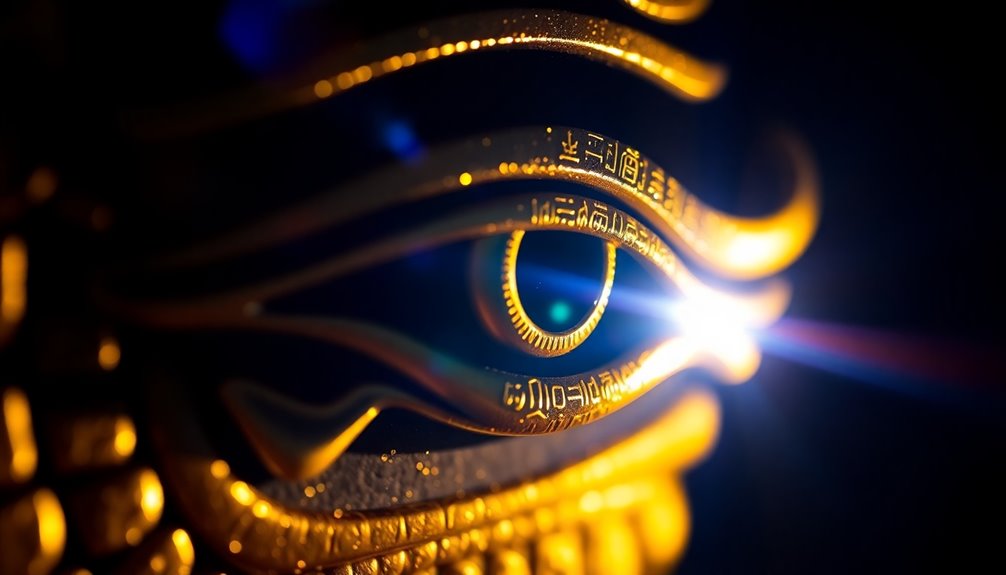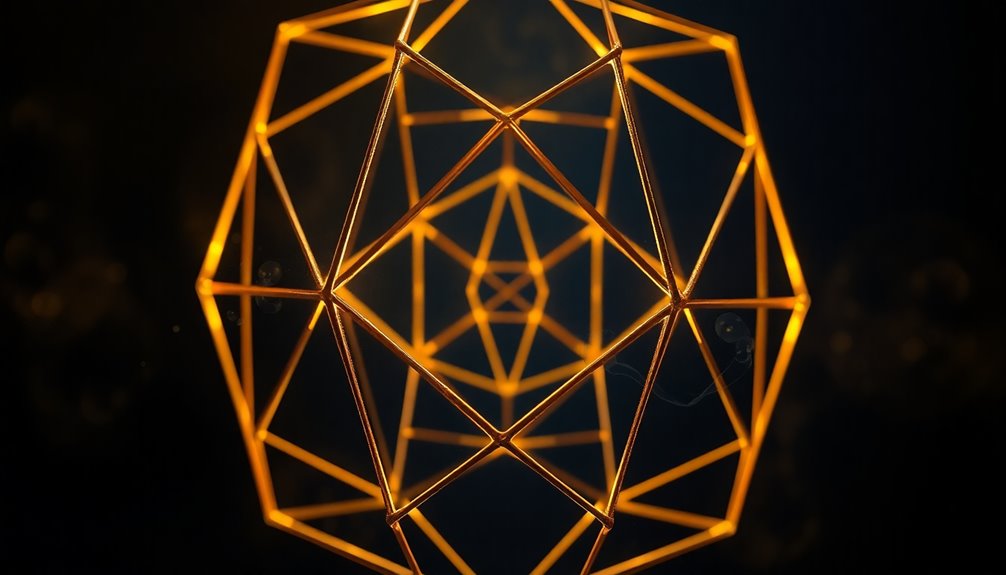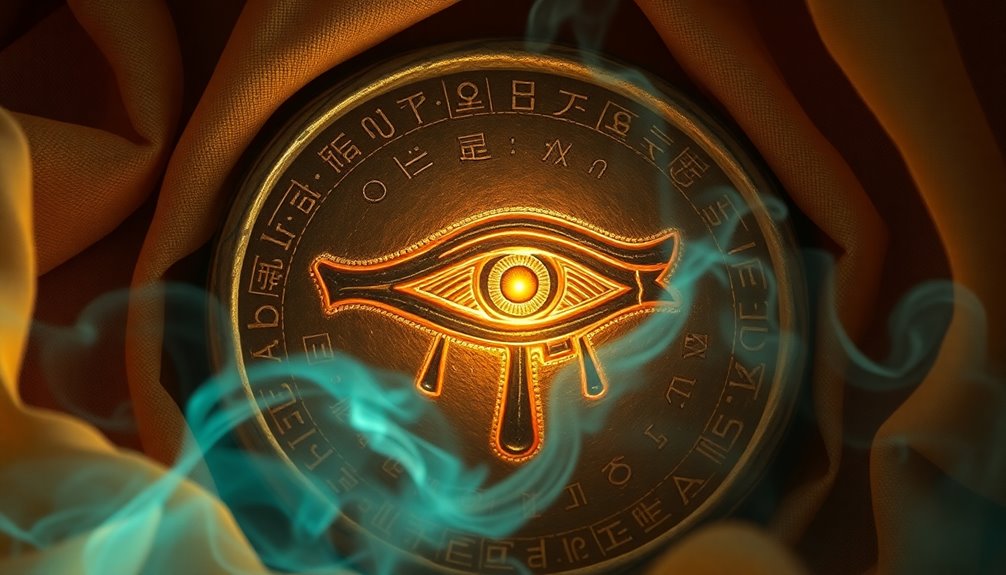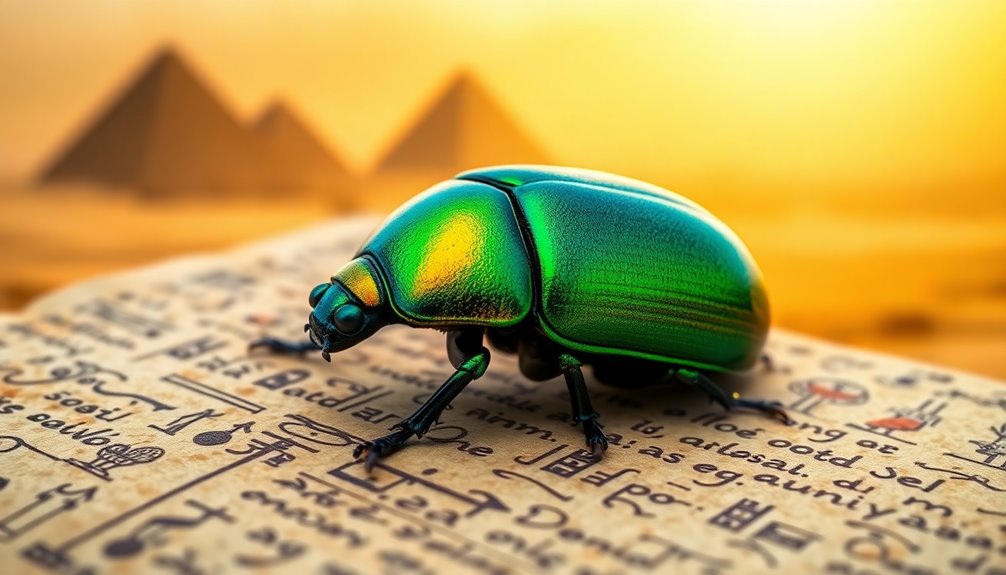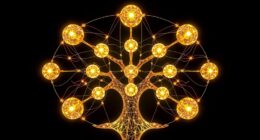The Eye of Horus is a powerful symbol of protection, healing, and spiritual awakening. It represents divine kingship and serves as a talisman, connecting you to ancient Egyptian wisdom. The pupil symbolizes healing and restoration, while the teardrop signifies sacrifice and rebirth. Worn in jewelry and amulets, it invites positive energy and spiritual insight. This iconic emblem has influenced cultures beyond Egypt, resonating in modern spirituality and art. By embracing the Eye of Horus, you can tap into its mystic knowledge and transformative power, guiding you on your journey toward deeper understanding. There's much more to explore!
Key Takeaways
- The Eye of Horus symbolizes protection and spiritual insight, serving as a powerful talisman against negativity and misfortune.
- It represents healing and restoration, invoking positive energy and a sense of security for the wearer.
- Rooted in ancient Egyptian mythology, it embodies a narrative of loss, struggle, and rebirth, connecting to eternal life.
- The symbol continues to influence modern spiritual practices, promoting intuition and spiritual growth in contemporary contexts.
- Found in art, jewelry, and tattoos, the Eye of Horus merges ancient mysticism with modern aesthetics, enhancing its cultural significance.
Symbolism of the Eye of Horus
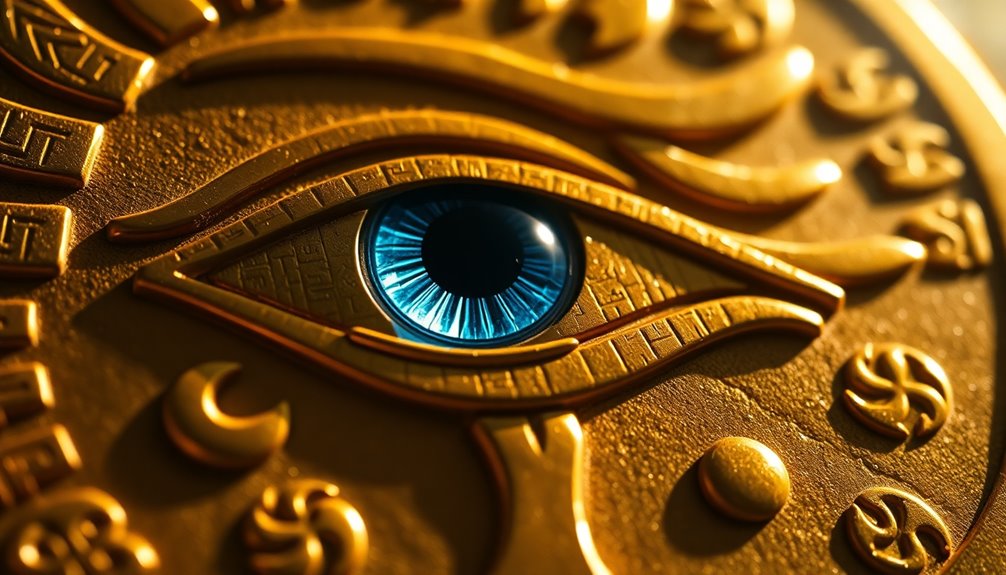
The Eye of Horus, often referred to as the "utchat," embodies profound symbolism in ancient Egyptian culture, representing protection, health, and restoration. This powerful symbol isn't just an eye; it's a complex representation of wholeness and well-being. The Eye of Horus symbolizes the journey through struggle and healing, especially in relation to Horus's conflict with Seth.
You might find it fascinating that each part of the Eye carries specific meanings. For instance, the pupil represents healing, while the teardrop signifies sacrifice and rebirth. These elements collectively convey the deep symbolism of the Eye as a guardian against misfortune.
In ancient Egyptian mythology, the Eye served as a talisman, commonly crafted into amulets and jewelry to protect both the living and the deceased. By wearing or carrying this symbol, you invoke the protection and healing it offers, creating a sense of security in your life.
The Eye of Horus remains a potent emblem of good fortune, reminding you of the enduring connection between health, safety, and spiritual wholeness. Embracing this symbol allows you to tap into its rich heritage and protective energy.
Mythological Background of Horus
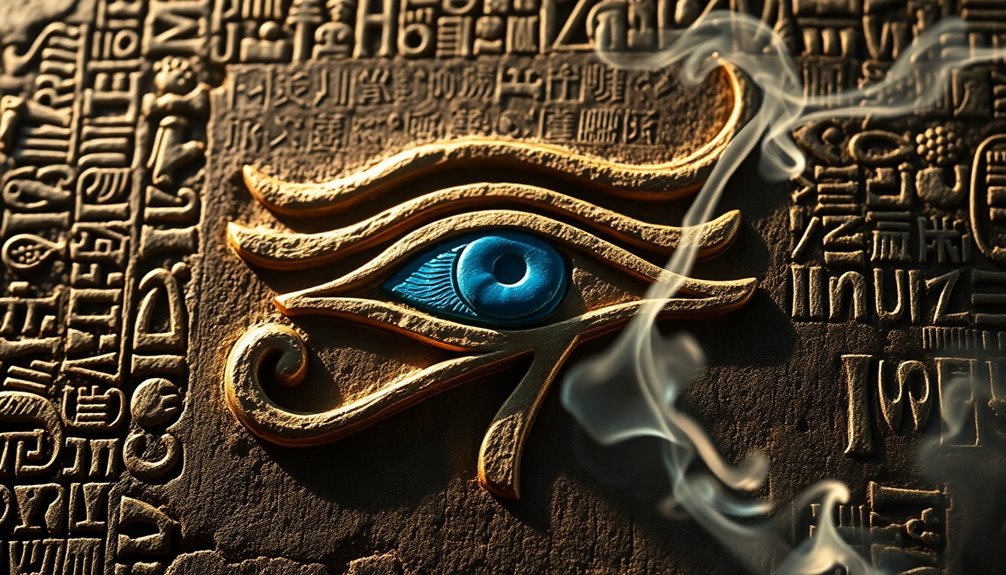
In ancient Egyptian mythology, Horus frequently emerges as a symbol of divine kingship and protection. As the son of Osiris, the god of the afterlife, and Isis, the goddess of magic, you'll often find Horus depicted as a falcon or a man with a falcon's head.
His mythological narrative centers around the struggle against Seth, the embodiment of chaos and disorder. This conflict not only highlights the battle between good and evil but also signifies Horus's rightful claim to the throne of Egypt.
A pivotal moment in this mythology occurs when Horus loses his left eye during the struggle. Fortunately, Hathor restores it, symbolizing healing and the cyclical nature of life and death.
This restored eye is known as the Eye of Horus, or "Udjat," which represents wholeness and protection. It embodies Horus's power to see all, serving as a safeguard against evil and misfortune.
Through his story, you can grasp essential themes of resurrection and kingship, illustrating how Horus is intricately linked to the divine right of pharaohs to rule in ancient Egypt.
Historical Significance in Egypt
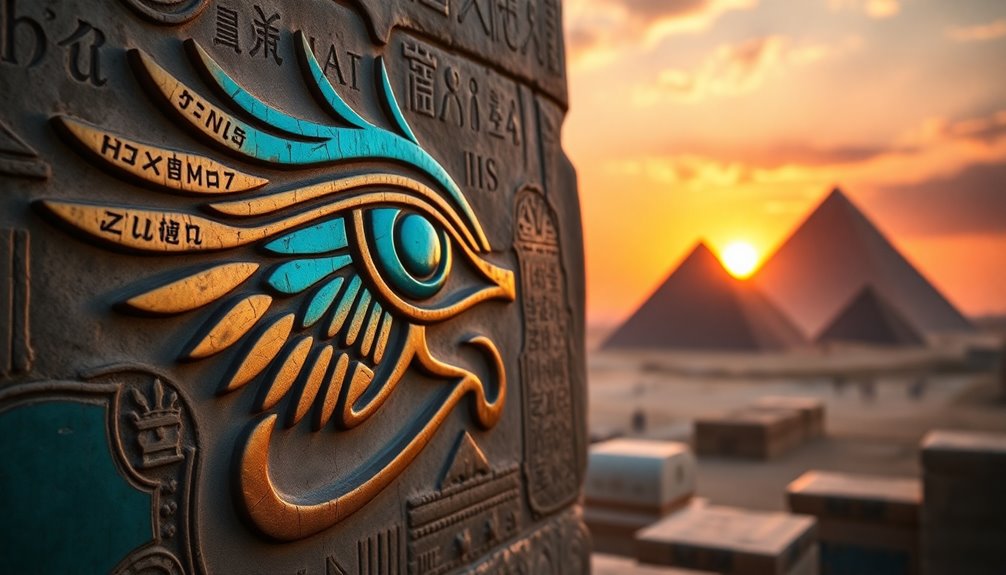
The Eye of Horus, or Ujat, has deep roots in ancient Egyptian culture, tracing back to the Early Dynastic Period.
Its mythological origins reflect not just a tale of loss and restoration, but also its role in daily life as a protective symbol.
As you explore its historical significance, consider how it influenced everything from royal power to funerary practices.
Origins of the Symbol
Symbolism of the Eye of Horus, or "utchat," is steeped in ancient Egyptian history, tracing its origins back to the Early Dynastic Period (c. 3100-2686 BCE). This powerful ancient Egyptian symbol embodies the meaning behind protection, royal power, and good health. The Eye of Horus wasn't just an emblem; it was believed to safeguard individuals in both life and the afterlife.
Its roots lie in the mythology of Horus, who lost his left eye in a battle with Seth. The eye's restoration by the goddess Hathor symbolizes healing and wholeness, emphasizing its significance in spiritual wellness.
You may have noticed that the Eye of Horus frequently appears in funerary practices, as it was thought to protect the deceased from malevolent forces. Moreover, this symbol adorned amulets and jewelry, serving as a potent talisman against illness and misfortune.
Its depiction in ancient Egyptian art, artifacts, and hieroglyphs illustrates its divine watchfulness and the critical connection between the physical and spiritual domains. The Eye of Horus continues to resonate, reminding you of its rich historical legacy.
Mythological Context and Events
Rooted in the rich tapestry of ancient Egyptian mythology, the Eye of Horus unfolds a narrative that captures the essence of the struggle between good and evil. This symbol, known as the "udjat," emerged from Horus's fierce battle with Seth, where he lost his left eye. The myth emphasizes themes of conflict and restoration, particularly when the goddess Hathor restored the eye, signifying healing and wholeness.
The Eye of Horus held significant historical meaning in Egypt, especially concerning protection and authority. It became a crucial emblem in funerary practices, safeguarding the deceased on their journey to the afterlife.
| Symbolism | Description |
|---|---|
| Eye of Horus | Represents protection and health |
| Restored the Eye | Symbolizes healing and renewal |
| Association with Pharaohs | Signifies divine right and royal authority |
Ancient Egyptians revered the Eye of Horus as a magical emblem, believing it could ward off evil and guarantee safety. Its presence in tombs and royal artifacts reflects the deep spiritual connection between the ancient Egyptian gods and their people's belief in life beyond death.
Usage in Daily Life
Ancient Egyptians integrated the Eye of Horus into their daily lives as a powerful symbol of protection and well-being. Known as "utchat," this emblem played an essential role in the ancient Egyptian civilization, serving as a safeguard against evil spirits and misfortune.
You'd often find the Eye of Horus adorning amulets and jewelry, worn by individuals seeking health and restoration.
In funerary practices, the Eye of Horus was placed on tombs and burial artifacts, ensuring the deceased's protection in the afterlife. This reflects its significance in both life and death, emphasizing its role as a symbol of protection.
The Eye also adorned the royal regalia of pharaohs, representing their divine right to rule and underscoring their authority.
Moreover, ancient Egyptians believed in the magical properties of the Eye of Horus, utilizing it in medicinal practices to ward off illness and promote overall well-being.
You could see this powerful symbol in various forms of art and architecture, signifying stability and divine insight—integral aspects of the cultural and spiritual life of ancient Egypt.
Eye of Horus in Ancient Religion

In ancient religion, the Eye of Horus serves as a potent reminder of the myth between Horus and Seth, where loss and restoration intertwine.
This symbol not only represents healing but also plays a vital role in funerary practices, ensuring protection for the deceased.
You'll see how its significance extends beyond mere decoration to embody deep spiritual meanings in life and death.
Myth of Horus and Seth
Battling for the throne of Egypt, the myth of Horus and Seth unfolds as a dramatic tale of revenge and cosmic struggle. As the son of Osiris and Isis, Horus seeks to avenge his father's murder by the chaotic god Seth. This fierce battle symbolizes the eternal conflict between good and evil forces.
Although Horus lost his left eye during the struggle, this loss becomes a pivotal moment in the narrative. The goddess Hathor restores his eye, representing healing and the cyclical nature of life and death.
From this myth, the Eye of Horus, or Udjat, emerges as a powerful emblem of protection and good health. It embodies Horus's strength, vision, and insight, acting as a safeguard against harm.
Ancient Egyptians wore the Eye of Horus in jewelry and art, believing it could shield them from evil forces and guarantee well-being in both life and the afterlife. This rich symbolism underscores Horus's role as a protector, reinforcing the significance of the Eye of Horus as a talisman against chaos, embodying the triumph of order over disorder in the divine domain.
Symbolism in Funerary Practices
While the Eye of Horus served as a powerful symbol of protection, it played an essential role in ancient Egyptian funerary practices. This protective symbol was believed to safeguard the deceased as they commenced their journey to the afterlife.
You'd often find amulets featuring the Eye of Horus placed in tombs, specifically designed to guarantee the soul's protection and ward off any evil spirits threatening their change into the next life.
In tomb paintings and inscriptions, the Eye of Horus symbolized not only protection but also restoration and healing, reflecting the Egyptians' belief in resurrection and eternal life.
It was frequently depicted alongside other protective symbols, like the scarab, reinforcing its importance during funerary rituals.
Modern Interpretations and Usage
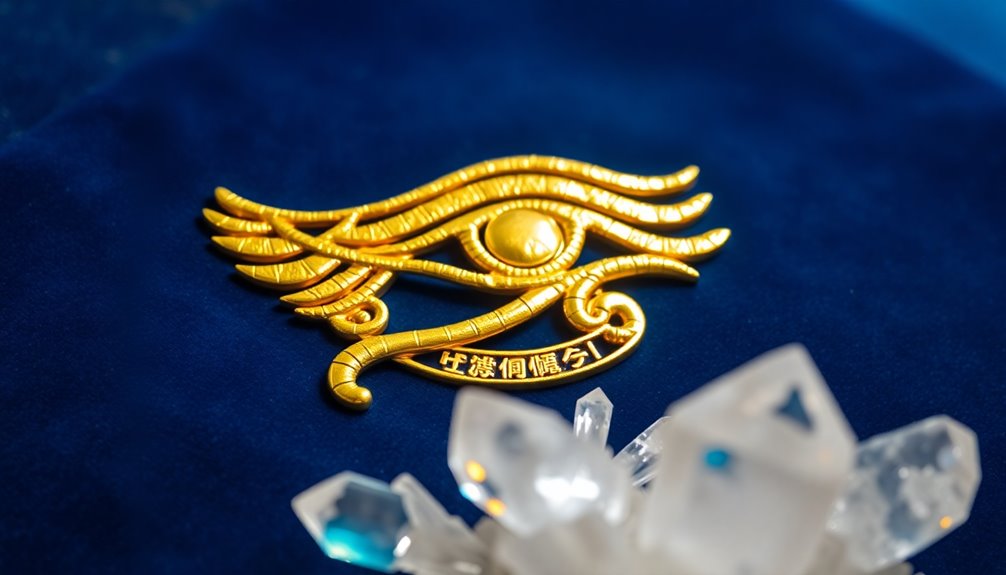
The Eye of Horus has found a vibrant place in modern culture, often seen as a powerful symbol of protection and spiritual growth. You might notice this emblem in contemporary jewelry, where it's worn as a talisman designed to ward off negativity and misfortune.
In various modern spiritual practices, the Eye of Horus is linked to themes of spiritual awakening and intuition, encouraging you to explore higher consciousness.
This symbol also thrives in art and design, merging ancient mysticism with modern aesthetics. You may even find it inked in tattoos or featured in fashion, showcasing its versatility and appeal.
The Eye of Horus has transcended its ancient origins, inspiring New Age movements focused on healing, protection, and self-discovery.
Additionally, its presence in popular culture—whether in films, literature, or merchandise—reflects its enduring significance and universal allure.
The Pineal Gland Connection
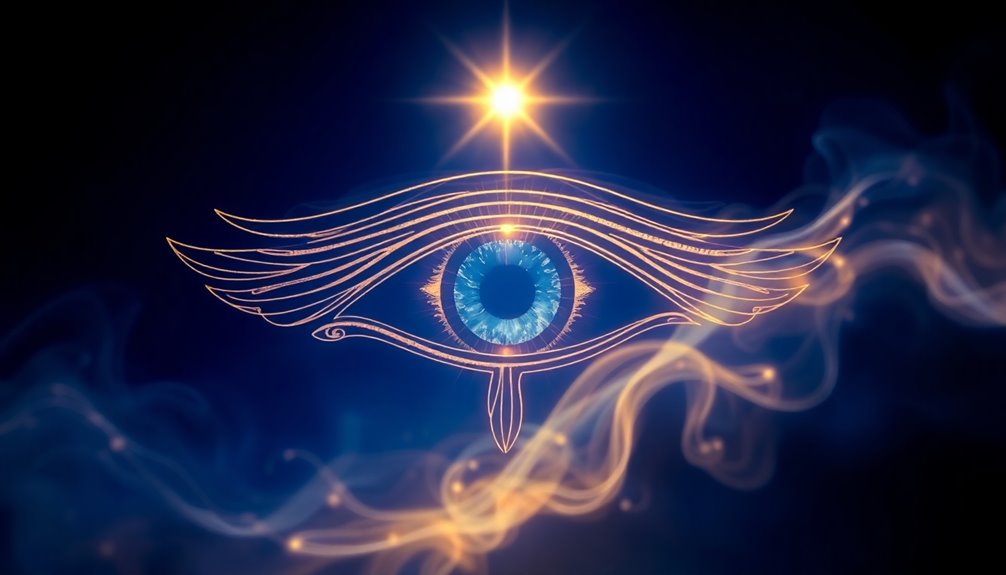
The pineal gland, often called the "third eye," plays a crucial role in your spiritual awakening and intuition.
Its connection to the Eye of Horus symbolizes wisdom and higher consciousness, bridging ancient mysticism with modern understanding.
Pineal Gland Overview
Understanding the pineal gland's role in both physical and spiritual spheres reveals its significance as the "third eye." Nestled near the brain's center, this small endocrine gland regulates your sleep-wake cycle by secreting melatonin. Additionally, maintaining a balanced sleep schedule is essential for optimal mental clarity and overall cognitive function.
But its influence goes beyond mere biology; it's deeply intertwined with spiritual practices and higher states of consciousness. Many traditions link the pineal gland to intuition and enlightenment, suggesting it plays a critical role in spiritual awakening.
Its unique structure, containing photoreceptive cells like those in your retina, hints at its sensory perception capabilities. This connection emphasizes the pineal gland's potential for spiritual insight, allowing you to perceive beyond the physical domain.
Moreover, the pineal gland can produce endogenous DMT, a naturally occurring psychedelic compound associated with visionary experiences. This further solidifies its reputation as the third eye, facilitating deep exploration of consciousness.
In esoteric traditions, the Eye of Horus symbolizes inner wisdom, echoing the pineal gland's role in guiding you towards greater understanding and insight. Embracing the significance of the pineal gland can enhance your spiritual journey, revealing deeper knowledge and awareness. Additionally, engaging in practices that promote cognitive performance may aid in unlocking the full potential of your pineal gland.
Spiritual Awakening Significance
Spiritual awakening often involves a profound shift in consciousness, where the pineal gland plays a significant role as your inner guide. This tiny gland, often referred to as your "third eye," links you to the mystical properties of the Eye of Horus, symbolizing wisdom and spiritual insight.
As you explore this connection, consider the following imagery:
| Symbol | Meaning | Connection |
|---|---|---|
| Eye of Horus | Inner eye of wisdom | Facilitates spiritual insight |
| Pinecone | Symbol of the pineal gland | Represents enlightenment |
| All-seeing eye | Higher consciousness | Guides your spiritual path |
| DMT Production | Visionary experiences | Enhances altered states |
Ancient Mystical Connections
Numerous ancient cultures recognized the profound significance of the pineal gland, often associating it with the Eye of Horus. This mystical symbol, known as the Eye of Horus, represents intuition, spiritual insight, and higher consciousness.
In ancient Egypt, the Udjat eye frequently appeared alongside a pinecone, directly linking it to the pineal gland. This connection underscores the belief that the pineal gland serves as the "third eye," a gateway to enlightenment.
The Djed pillar, symbolizing stability and spiritual regeneration, further emphasizes the importance of the pineal gland in ancient Egyptian practices. It suggests that the ancients understood its role in achieving a balanced state of being, aligning physical and spiritual domains.
Ancient texts and iconography reveal that Egyptians possessed esoteric knowledge about the pineal gland, which heavily influenced their religious rituals and healing practices.
Today, the Eye of Horus continues to resonate as a symbol of ancient mystical connections, bridging the gap between consciousness and spirituality.
As modern interpretations unfold, you may find a growing interest in how these ancient teachings inform contemporary spiritual journeys, highlighting the timeless quest for deeper understanding.
Cultural Impact Across Civilizations
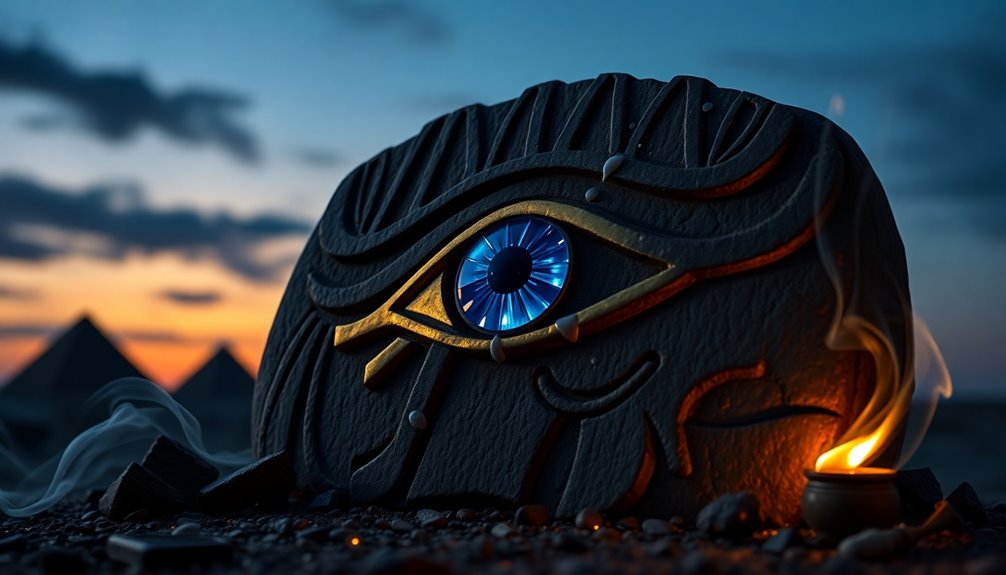
The Eye of Horus has considerably shaped cultural narratives across various civilizations, transcending its origins in ancient Egypt. This powerful symbol of protection has been embraced by the Greeks and Romans, who adapted its meaning to reflect their own beliefs in divine insight.
Throughout history, the Eye of Horus has adorned numerous cultural artifacts, serving as a talisman of vigilance and watchfulness.
Imagine the Eye of Horus appearing in:
- Intricate jewelry worn by ancient Egyptians
- Decorative pottery embellished with protective symbols
- Elaborate murals depicting the deity's watchful gaze
- Modern fashion items that echo its enduring significance
Each representation highlights the ancient Egyptians' belief in protection over both the living and the dead.
In today's world, the Eye of Horus continues to resonate, showing up in contemporary art and spiritual practices. It evokes themes of spiritual awareness and ancient wisdom, proving its timeless appeal.
You can see how this emblem remains relevant, enchanting the imagination of countless cultures and individuals across generations. The Eye of Horus is more than just a symbol; it's a bridge connecting past beliefs to modern expressions of protection and insight.
Eye of Horus in Art and Design
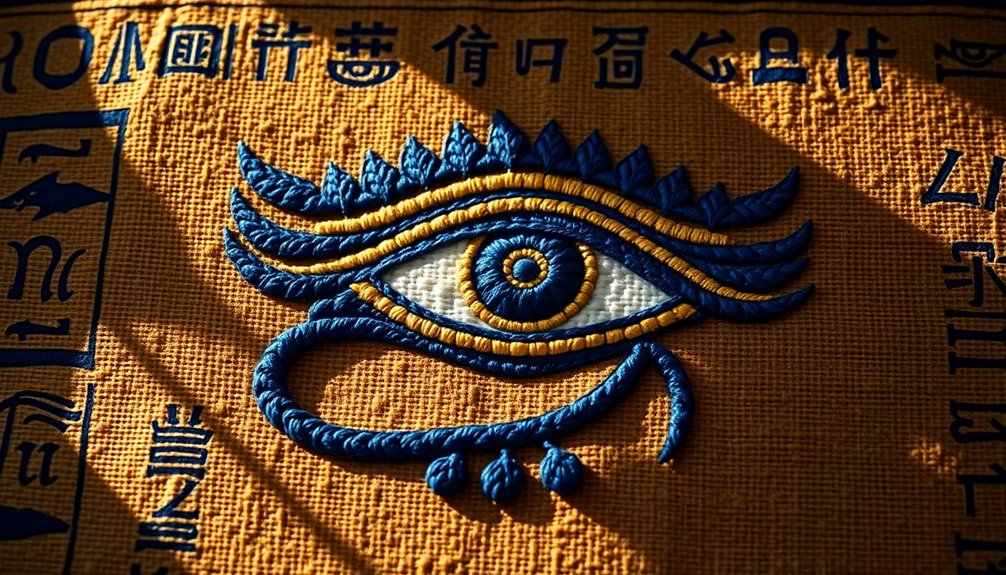
With its rich history and deep meanings, the Eye of Horus has found a vibrant place in art and design today. This ancient Egyptian symbol resonates deeply with contemporary artists and designers, representing themes of protection and mystical insight.
You might notice its influence in the works of renowned artists like Salvador Dali and Pablo Picasso, who embraced the Eye of Horus to convey complex ideas.
In modern jewelry, the Eye of Horus often graces pieces crafted from gemstones and metals, merging aesthetic beauty with spiritual significance. You can see it in graphic design, logos, and tattoos, where it symbolizes vigilance and a quest for knowledge, reflecting diverse cultural contexts.
Fashion designers, such as Alexander McQueen, have integrated the Eye of Horus into their collections, blending ancient symbols with modern aesthetics to evoke powerful connotations.
Additionally, its influence extends to architectural design, where the layout of temples and structures in ancient Egypt showcases the interplay of art, spirituality, and geometry.
The Eye of Horus continues to inspire and captivate, reminding you of the enduring power of this timeless symbol in art and design.
Talisman and Protective Functions

Wearing the Eye of Horus as a talisman offers a profound sense of protection and spiritual insight. This ancient symbol, known for its protective functions, has safeguarded wearers against evil spirits and misfortune for millennia.
Each component of the Eye carries unique meanings that enhance its power:
- The pupil symbolizes healing, promoting physical and emotional wellness.
- The teardrop represents sacrifice and rebirth, reminding you of resilience.
- The surrounding markings embody strength, guaranteeing you remain grounded in challenging times.
- The overall design reflects harmony, attracting positive energy to your life.
In ancient Egyptian culture, the Eye of Horus was more than just a symbol; it was believed to possess magical properties that could ward off illness and misfortune. Inscribed on tombs and funerary artifacts, it guaranteed protection for the deceased on their journey into the afterlife.
Today, people still embrace the Eye of Horus as a powerful talisman, seeking clarity of mind and shielding from negativity. By incorporating this symbol into your life, you not only honor its rich history but also invite its protective energy into your daily existence.
Famous Artifacts Featuring the Eye
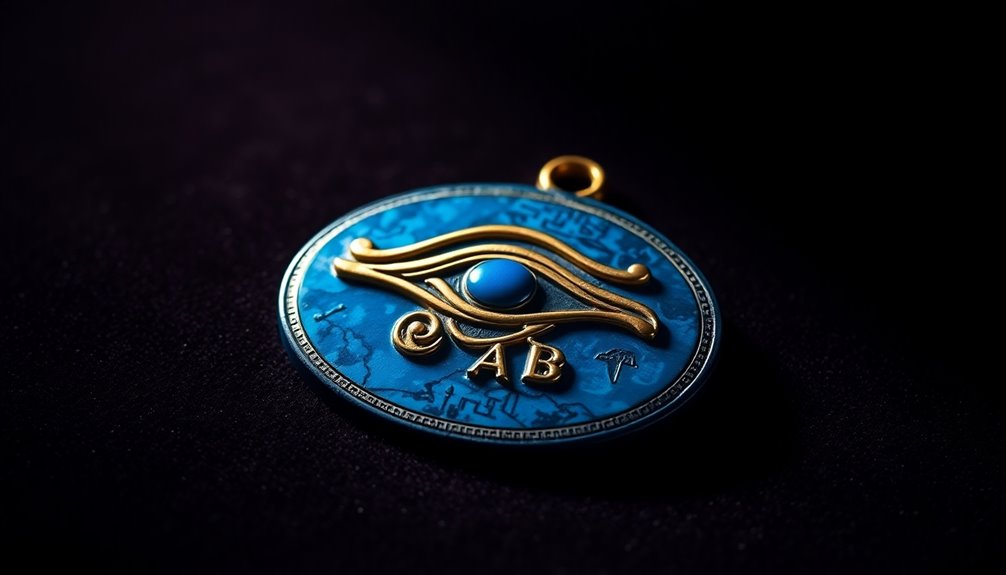
Throughout history, numerous artifacts have showcased the Eye of Horus, each reflecting its deep significance in ancient Egyptian culture. One of the most famous is the Coffin of Tutankhamun, where the Eye of Horus symbolizes protection and royal power for the young pharaoh as he sets out on his journey to the afterlife.
Similarly, the Papyrus of Ani, an ancient funerary text, features spells and illustrations of the Eye, serving as a guide for the deceased.
The Temple of Horus at Edfu stands as a remarkable indication of the Eye's importance in religious practices. Its extensive carvings highlight the Eye's role in protection rituals.
Additionally, the Rosetta Stone, essential for deciphering Egyptian hieroglyphics, includes the Eye of Horus, symbolizing the divine authority that pharaohs wielded.
Lastly, the Narmer Palette, an ancient ceremonial artifact, depicts the Eye alongside other significant symbols, reinforcing its role in establishing royal legitimacy and power.
Each of these artifacts not only showcases the Eye of Horus but also encapsulates the deep spiritual meanings and protective qualities revered by the ancient Egyptians.
Frequently Asked Questions
What Does the Eye of Horus Symbolize Spiritually?
The Eye of Horus symbolizes spiritual protection, healing, and wholeness. It acts as a safeguard against negativity while promoting well-being in your life.
This ancient emblem connects you to deeper insights and higher consciousness, often linked to the pineal gland, or "third eye." As you explore your spiritual journey, the Eye of Horus encourages self-discovery and transformation, reminding you of the power of restoration and the importance of maintaining balance in both domains.
What Happens When You Wear the Eye of Horus?
When you wear the Eye of Horus, you're embracing a symbol of protection and healing.
It acts as a shield against negative energy, helping you feel secure. You might notice an increase in your intuition and spiritual insight, guiding you on your journey.
Many people find that it attracts good fortune and fosters a connection to ancient wisdom, enhancing not just your spiritual growth but also your overall well-being and positivity in life.
What Is the Magic of the Eye of Horus?
The magic of the Eye of Horus lies in its protection, healing, and insight.
When you embrace this ancient symbol, you tap into its powerful energy, allowing it to guard you against negativity, promote your well-being, and enhance your intuition.
You'll find clarity in your thoughts, strength in your spirit, and comfort in times of hardship.
What Is the Power of the Eye of Horus?
The Eye of Horus holds significant power, offering protection and promoting healing.
When you wear or display this symbol, you tap into its mystical properties, warding off negativity and attracting good fortune.
Its connection to the pineal gland enhances your intuition and spiritual awareness, guiding you toward higher consciousness.
Conclusion
As you explore the Eye of Horus, you might find it appearing in unexpected places—perhaps a piece of jewelry or a mural in a café. This ancient symbol, rich with meaning, connects you to a world of mystic knowledge and protection. You realize that wherever you see it, there's a reminder of your own journey towards enlightenment. Embrace its significance and let the Eye guide you, as it has done for countless souls throughout history.

